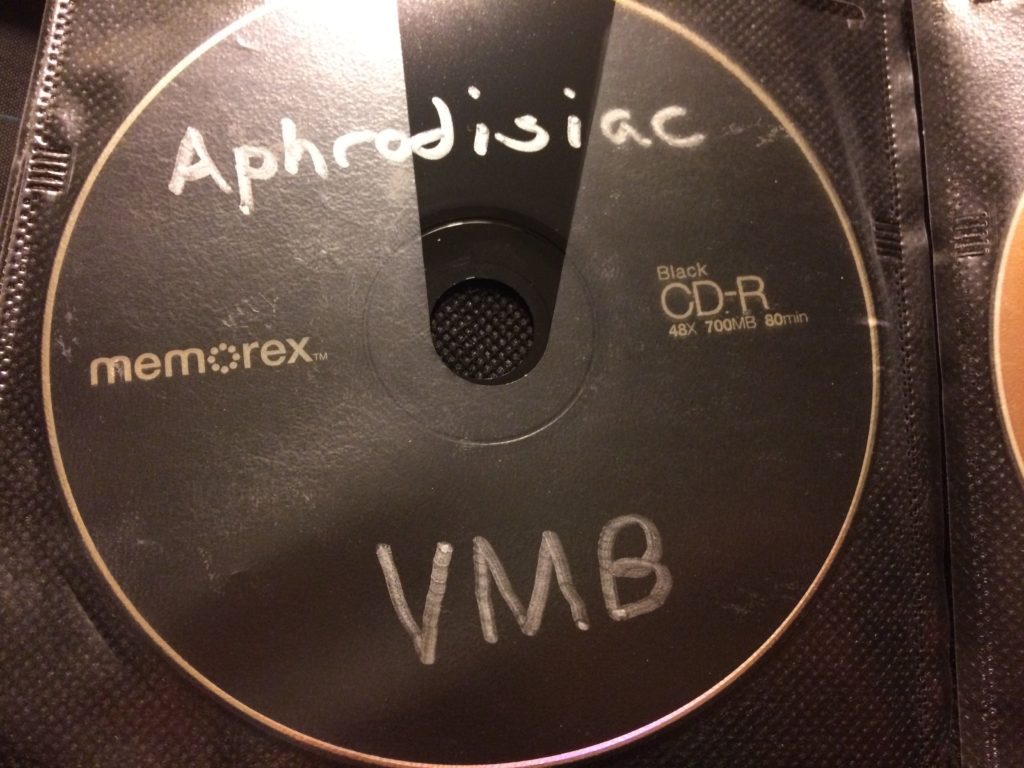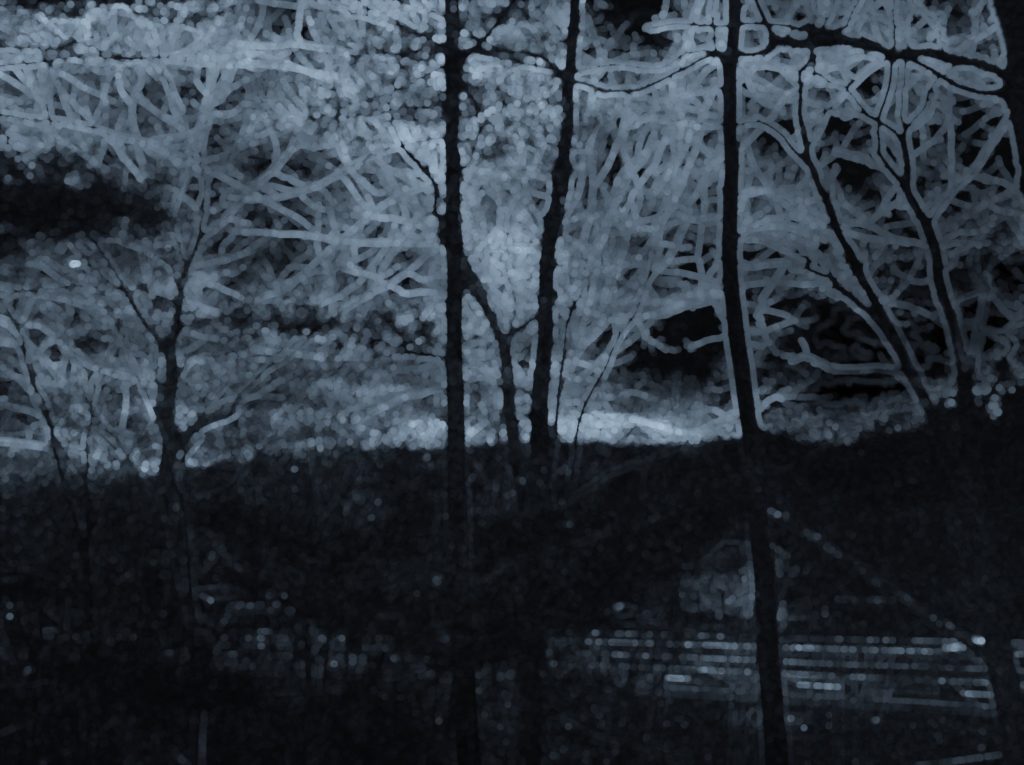Bufotenin
- Posted by mariteaux on February 15th, 2020 filed in Tunesmithing
- Comment now »
So here we go, part two of the aphrodisiac story. Various Murky Basements time. This is the relative high point of the story, my “rise” if you will. Gonna be a much longer blog post, but hey, I’ve got a lot to say. Let me get the audio geekery out of the way first and then I’ll reminisce.

As I explained in my last little expose on it, aphrodisiac was originally meant to be a proper band with Here Come Monsters acting as a demo to get musical friends on board. When I realized this wasn’t gonna happen, I decided to retool everything I’d done thusfar. It was for the best anyway; by the end of writing Here Come Monsters, I’d learned two little tricks that’d come to define the sound of the entire project.
The first little sonic trick, I’d picked up from my recent obsession with “low-bit” music, as it was called. MP3s are encoded at a controllable bitrate that lets the encoder lower the quality of the MP3 for a smaller file. Your average bitrates these days hang around 192kbps, 256kbps, or (idiotically) 320kbps. Low-bit music is encoded at closer to 32kbps, sometimes lower, letting the artifacting become a component of the music all on its own. Here’s a review I did of a low-bit techno album a while back. Genuinely nothing like it.
Low-bit’s fucking brilliant, really. It’s not really a “style” or a “genre” or even a “movement”. There’s low-bit techno, low-bit noise, low-bit ambient, low-bit chiptune, the lot. For all the anecdotes about how it came about for lack of hard drive space or slow internet speeds, it’s uniquely a personal thing. I mostly like the sounds of it, not just the sounds of the artifacting but that the producers of it seem to use the intentional messiness of the output as a way to experiment, to produce music they maybe wouldn’t otherwise.
One thing I found as I started to experiment was that Lame (the de facto MP3 encoder, and I think the only real prominent one aside from maybe Fraunhofer’s own MP3 encoders) was, ironically, not very good at artifacting! If I recall, at ~32kbps, it sounded mostly like a low-pass, very flat and muffled, but no real “artifacting” to speak of. Seems it was too good to help me much in my quest to make things sound bad.
Now, the funny thing about MP3 encoding is that the original standard doesn’t define much outside of what an output MP3 should look like. In normal people words, two MP3 encoders can sound way different at the same bitrate. This is where the fun starts, because that means they all artifact differently, and there were many competing MP3 encoders around in the late 90s and early 2000s, all using bits and pieces of dist10 code and homebrew tweaks to varying degrees of effectiveness.
My weapon of choice ended up being the very very old BladeEnc. BladeEnc only went down to 32kbps, but this worked fine for me, as it sounds like actual ass down that low. I love it. Here’s a sample:
BladeEnc is my favorite old MP3 encoder for low-bit stuff for a few reasons:
- I’ve never heard another encoder blip and shimmer quite like BladeEnc.
- On transients (that is, sudden bursts of loud sounds), BladeEnc will cut out briefly but audibly. I think it has something to do with a lack of headroom in the input just getting muted if it clips in the output.
- It really still tries its damndest with the high frequencies, despite just not being able to handle stuff up there. Lame is too smart for this and will low-pass to increase quality if possible.
- The code is portable as fuck and rock solid despite being almost 20 years old. You’ll only generally find binaries for Win32 lying around, but I was able to compile it for 64-bit OS X using Xcode with not a change to either the code or the tools.
Where I found BladeEnc most useful was on drum machines. As a drummer myself, I’m pretty anal about drum sounds, and softdrums are notorious for being very sterile, something I was keen on avoiding. Drums are also traditionally very difficult for an encoder thanks to their high frequencies and sharp transients, and at bitrates that low? I was gonna get something neat out of it no matter what.
While I was experimenting, I found that GarageBand’s Crate Digger drum machine, ostensibly an early 90s hip-hop kit, could get turned into industrial machinery if you floored the overdrive and reverb on it. It wasn’t a clean digital reverb by any metric, it’s hard to explain. Anyway, this ended up being the aphrodisiac drum machine, enough to fill a mix to the point where I need to drop it a good 8db to avoid blasting everyone’s ears out. I then usually double it with a “dry” (no reverb) drum machine for added punch.
Paired with BladeEnc, Crate Digger ends up sounding like a brick in a washing machine:
My other sonic trick is a lot less involved. I realized GarageBand’s softamps could be used for any arbitrary audio clip, and thus, I started to run synths, voice samples, fuck, more drum machines–everything through these things. At first, I merely rendered out individual instruments and then imported them back in to get at GarageBand’s presets, but later, I discovered the effects chain could be used to get a customized amp + pedalboard effect on any instrument, even a software one, without an export.
Now, I was able to make the formerly limp and pathetic software “guitars” sound much more powerful. Software basses could be roughed up, fuzzed to hell, and voices could hang in an endless void, airless and tinny. I still use the softamps on about everything I can–“Another Deserted Urban Complex”‘s Home Shopping Club sample is on a track with a pedalboard in its effects chain, and the delay on the pedalboard is set to reverse. This is how the sample doubles in on itself and glitches the way it does.
I took two songs from Here Come Monsters with me into this new EP–“Caleb”, which was switched from an opener to a closer, and “Mind Left for Seattle”, which got pretty significantly reworked. The other three tracks were all written brand new in the spring of 2016.
“Various Murky Basements”
Let me get the name of this track and the EP out of the way first. “Various murky basements” comes from a bit in Zero Punctuation‘s review of Pokémon White. I just liked the phrase, and given the clangy drum machine, I thought my EP sounded, fittingly, like a damp basement.
You know in the intro to Syndicate Wars where the lad who lives in the dystopian nightmare city has this chip in his head that makes him think he’s living in picturesque small town America? I like to think the protagonists of Pokémon all have the same chips and are in reality exploring various murky basements with a sackful of rats and mangy attack dogs.
The eponymous opener, much like how “Caleb” was fashioned after “Burned”, was a take on Silversun Pickups’ “Booksmart Devil” and actually features my drumming on it. On an e-kit, granted. One I later broke playing Rock Band. (I’m kind of a heavy hitter.) Where I could, though, I’d use it on songs to get some more varied note velocity and maybe some fills too.
This one saw the use of (I’m not kidding) a Honey Badger Radio sample in the background from one of their Ragenings I think. I went through a small period where I was a men’s rights activist, mostly because circumcision is wrong and I took “Karen took the fucking kids” a bit too seriously. Nowadays, all that’s just folded up into my overall libertarianism, but enough about my politics. I can’t be assed to find the original video, but there you go, that’s where the chatter is really from. Something autistic.
“A Membrane’s Virtuous Sky”
A lot of aphrodisiac tracks were just kinda called whatever I could think of when I scrawled the project name down. They don’t mean anything. This one’s just a stupid anagram of “Various Murky Basements”, again, for no real reason. I was very happy to officially rename it to something slightly more fitting on In Free Fall, along with a far less muddy and hard-to-hear mix.
This is another one with a Honey Badger Radio sample, or maybe it was one of Doctorrandomercam’s solo videos. I enjoyed his stuff for a good while until he got into a fucking slapfight with Mister Metokur and they both stopped appealing to me. In fact, let me just list off all the voice clips I can think of in any of my tracks and where they come from:
- The aforementioned Honey Badgers
- A clip of Metokur from his “Tumblrisms: Otherkin” video as an interlude at the end of the redone “Mind Left for Seattle”
- A clip of detectives chattering from Homicide: Life on the Street in both versions of “Chimerical”
- A long-lost Vocaroo someone sent Milo Yiannopoulos (listen, it was 2015, people still gave a shit about ethics in big black cock) on both ends of “Didanosine” (which as I found out again, is AIDS medication, and I probably named it that as a stealth joke about faggotry)
- A glitched phone operator reading off a number of all zeroes on “From Somewhere in the House…”
- A clip of I Hate Everything screaming “orange chicken and rice” from a stream he did long, long ago after the first chorus of “Apologies to the Disco Jellyfish”
- Of course, prengle’s infamous voicemail to me on “Kaden”
- And for the crème de la crème, “Lauren” is quite literally “You’re a Wizard Harry” under 30 layers of Audacity reverb with no further editing
“The Rhesus Monkeys in Floaroma”
“Floaroma” refers to Floaroma Town, a location in Sinnoh in Pokémon, and “rhesus monkey” refers to Chimchar. I likely meant Twinleaf Town, where you start the game. Told you these names are fucking dumb.
This one held the record for the quickest a song came together until the mtlx tracks knocked it down this year. I think I finished the whole thing in a weekend at the tail end of writing the album. Some of these songs were started and then finished in a totally separate month. Kinda wild how I used to work, really.
“Floaroma” was so short that I tacked on an intro I called “Drowned” (not named for Brianna amazingly, but for one of the patches I used on it, Drowned Sines), which has the only other recording of my e-kit in existence. Those little hi-hat rolls were fun to play. When it came time to punch it up for In Free Fall, I left “Drowned” off, redid some of the patches, and renamed it to “Ventolin” after the stuff in Caby’s inhaler.

As for the album art, I also have a story about that. By the time I was finishing the EP in May 2016, I was utterly absorbed in the “distorted and repurposed” aesthetic I was playing with musically. That spring, I enrolled in an early-morning high school photography class, and we’d frequently wander out onto the playground near the creek to take pictures for projects. In time for one of our expeditions, my normal camera had conveniently been left uncharged. I was handed a loaner Nikon D50 to use instead.
Something went seriously wrong with this camera as we got out there. Every single one of my pictures grew insane pink and green icicles and melting, vivid bands of color, sometimes rendering the original picture unrecognizable. (Turns out, this is a known issue with the D50, but the specific cause can vary between your battery, SD card, and the sensor. In my case, I think it was a temperature thing.) In anyone else’s hands, they’d just stop taking pictures. In mine? I was gonna take as many as possible. One of these shots became the album’s artwork; others were used for my first Neocities site’s banners.

Unfortunately, all the originals are now long-lost. That wonderful fusion drive crash took it all with them and I didn’t back them up or anything. These only survive because I sent them to Jax. Oh well, keeping better backups now, lesson learned.

I had my EP now. Various Murky Basements. The flow was tight. aphrodisiac was heavier than ever. I was finally ready to get it out there.
Now, I didn’t have a bank account at the time, and despite being proud of it, I still didn’t think it was anything actually worth money. Instead, I made it a free download on Bandcamp and handmade five CD-R copies using cardstock and jewel cases. These came with MP3 copies of the album, plus some “liner notes” on the enhanced portion of the disc…along with a little something extra.
The response I got to the EP was really positive, surprisingly so. I meant to hand these out to a few select friends to see what they thought of it, and I expected to be given them all back politely accompanied by a nod, basically, but to my surprise, a few of them actually wanted to keep their copies. The rest of my stock ended up in the hands of people who went (to my face no less) “I’d actually listen to this, can I have a copy?” Indeed, aside from the master CD-R I burnt for myself that you saw at the start of this post, I don’t actually have a physical copy of Various Murky Basements of my own.
I had to go further. I had to get it on Spotify.
As I said before, since it was still kinda demo-quality, I didn’t want to sell Various Murky Basements, but I did want to get it online for people to at least stream and download if they wanted to. I started looking into distributors to see if I couldn’t get it on something like Spotify or Apple Music, really just to see if I could. I ended up going with RouteNote because, well, they were free, and I was 16 and poor.
To my surprise, it all worked out! I just handed off the tracks and waited, and Various Murky Basements went up on Spotify within a few weeks. Sure, it was next to some other Aphrodisiac projects, but I didn’t mind that much at the time. I was just amazed that something I made was on there. And it was easy!
Yet, it wasn’t enough. Having real-life friends into it and being ~distributed~ wasn’t enough. I had to go further. I had to get some press involved.
Through the low-bit stuff, I found the still rather active Yeah I Know It Sucks, which is an oddball netlabel and experimental music review blog that I felt would be appropriately underground enough to take on my little home-recorded noise rock project. I was nervous, but nevertheless, I shipped it off to them via email and waited a few weeks for a torching or a blessing.
What I got back was this almost-coherent review where my EP was compared to a monkey’s ass getting spanked. Positively. And I loved the shit out of it, man. It felt like I’d come full circle from using clips of drunken man rambling in my songs to getting reviews consisting of drunken man rambling. Simon Hit, wherever he is, bless him. He could’ve trashed it. He could’ve called it the undercooked hamburger patty it really was. Instead, he rambled about Ronald McDonald’s clown shoes. Still makes me smile.
It’s obscenely late and my eyes are starting to hurt. Point is, this was a big moment for me. This little homemade EP of mine, filled up with noisy samples and squishy drums, was now in people’s hands, was up online, and I sent it to a blog I liked and they seemed to like it too. Our journalism teacher blasted the entire thing the day I brought it in as we worked. It was totally different from what I thought I’d do with this whole aphrodisiac thing, and in fact, it was far, far better.
So where’d I end up going with it all? Not far, but that’ll have to wait for a part three…
